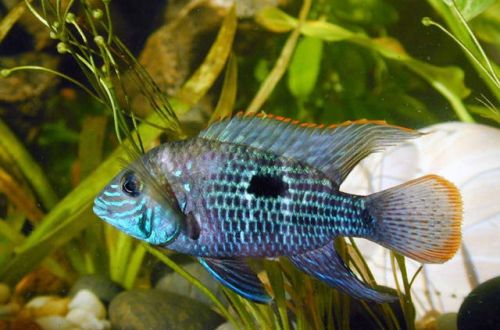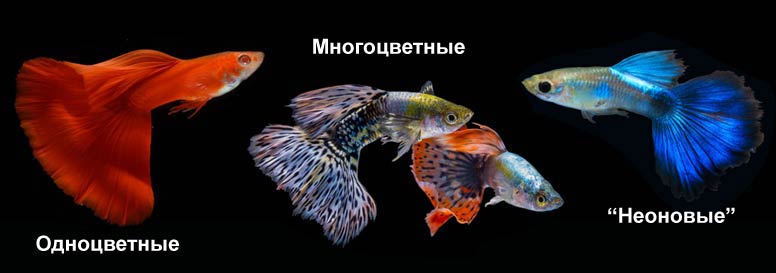
Guppy
Guppies are one of the most popular aquarium fish. They are easy to keep and breed, have a peaceful disposition and are compatible with most other species, and the number of color variations is in the hundreds.
However, despite the existing diversity, in reality, only three species are represented in the aquarium trade: the Endler Guppy, the Swamp Guppy and the Common Guppy. All the rest are the result of artificial selection.
There is no universally recognized classification or a single catalog, therefore, associations of breeders (Clubs, Societies), even in one country, can separate and name the same fish in different ways.
However, due to regular international competitions and constant exchange of experience (mixing of populations), guppies from suppliers from Asia, Europe and America will have the same set of features in color, body pattern, shape and pattern of the caudal fin. It is the presence of one or another feature that will serve as the basis for the classification in this article.
Contents
Body color classification
Guppy classification by body color
 Illustration of differences in body color between varieties of Guppy fish
Illustration of differences in body color between varieties of Guppy fish
Conventionally, three main color options can be distinguished: solid monophonic (red, yellow, green, blue), motley multi-colored and neon, which is sometimes called metallic. If the features of the first two are quite obvious, then the third variety requires explanation. The fact is that Neon guppies have additional cells in the body – iridophores that are not found in others. Thanks to them, metallic reflections appear in the color, while the color itself can be very diverse.
Classification according to the shape of the tail
Probably the only generally accepted classification of Guppy, which can be found in breeders around the world. It was formed in the early 2000s and includes 12 varieties.
Guppy classification according to the shape of the tail
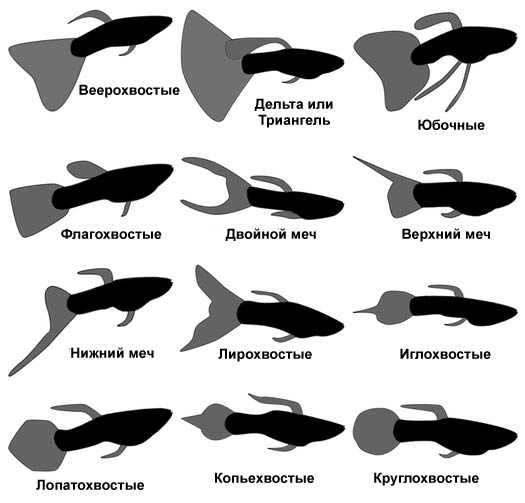 Illustration of twelve varieties of Guppies, differing in the shape of the tail
Illustration of twelve varieties of Guppies, differing in the shape of the tail
In 2015, the 1st Intercontinental Guppy Championship took place at the Aqua EXPO Tage site in Dortmund, where four new varieties of guppies with previously unknown tail fin shapes were presented: “crescent”, “ribbon”, “swallow” and “crown”.
Since then, there have been proposals to expand the classification to 16 varieties, and they may already be found in some sources.
Body pattern classification
Guppy classification according to body pattern
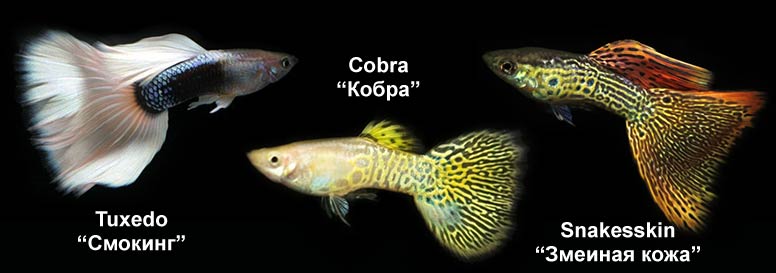 An illustration of the differences in body pattern between the crown varieties of Guppy fish: Tuxedo (tuxedo), Cobra (cobra), Snakeskin (snakeskin)
An illustration of the differences in body pattern between the crown varieties of Guppy fish: Tuxedo (tuxedo), Cobra (cobra), Snakeskin (snakeskin)
Tuxedo (tuxedo) – The front of the body is lighter than the back. The contrast is most pronounced in black and white varieties, resembling a tuxedo in color.
Cobra – on the body there are vertical stripes and specks, the shade of which differs from the main color.
Snakeskin (snakeskin) – the body is decorated with a pattern of numerous rosettes, passing one into another. Coloring may include gold, black and orange patterns.
Classification by tail pattern
Guppy classification by tail pattern (Leopard and Mosaic)
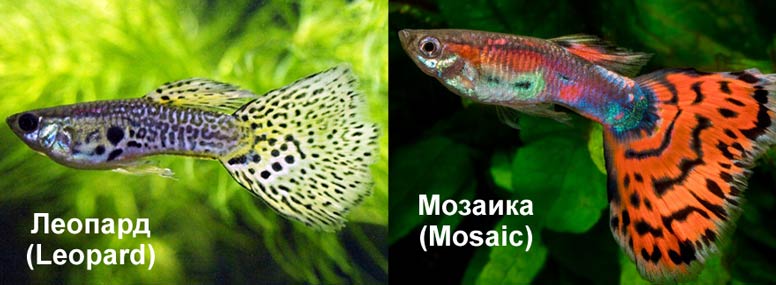 Illustration of the differences in Guppy tail pattern between the Leopard and Mosaic varieties
Illustration of the differences in Guppy tail pattern between the Leopard and Mosaic varieties
Leopard – the pattern consists of a series of rounded intersecting spots, sometimes forming uneven lines, which vaguely resembles the pattern on the body of a leopard.
Mosaic – a pattern consisting of numerous dark specks of spots that connect with each other and form an irregular pattern.
Guppy classification by tail pattern (Grass and Lace)
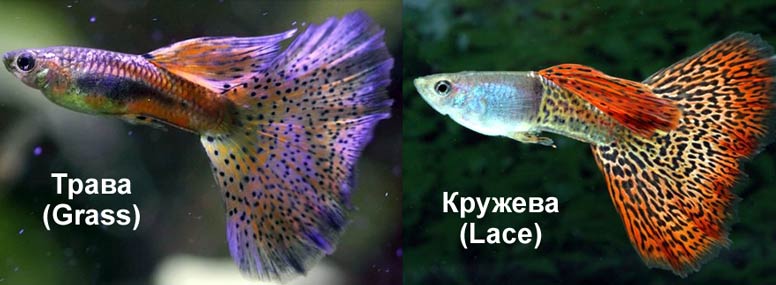 An illustration of the differences in Guppy tail pattern between Grass and Lace varieties
An illustration of the differences in Guppy tail pattern between Grass and Lace varieties
Grass – is a further development of the “Leopard” colors. It differs in smaller non-connecting spots, which, according to breeders, resemble a scattering of grass seeds.
Lace – the pattern consists of a fine mesh structure, resembling a woven web. Most often combined with the body pattern “Snakeskin”.
It is worth noting that classifications may differ depending on the author. This article does not claim to be absolute reliability, but only offers a universal way to systematize such a diverse group.
Guppy fish breeds
Considering that each Guppy breed can combine several of the listed features at once (body color, pattern and tail shape), the number of possible variations can be in the thousands. In addition, breeders regularly breed new breeds, so it is impossible to calculate their exact number.
The following are the most popular varieties and breeds that are most frequently mentioned in the aquarist environment.
Pick up fish with a filter
Guppy “Black Prince”
guppy albino
guppy yellow
Guppy green
Guppy cobra
Guppy swordtails
Guppy neon
guppy common
Guppy Tuxedo
Guppy Endler
Red Guppies
Micropecilia picta
Moscow guppies
Blue Guppies
black guppies




